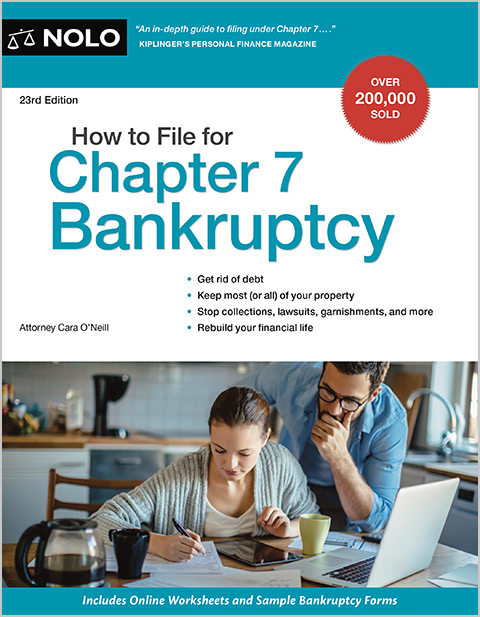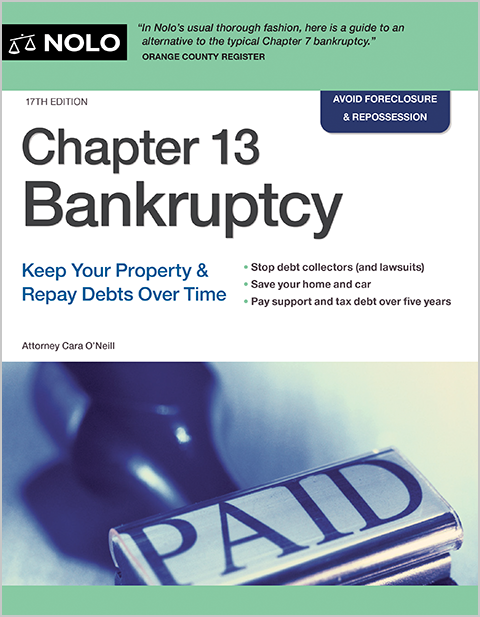 Your Debts in Chapter 13 Bankruptcy
Your Debts in Chapter 13 Bankruptcy
Here's how Chapter 13 bankruptcy generally works: You keep your property and repay some or all of your debts through a repayment plan which lasts for three or five years. How much you pay on a given debt depends on a number of factors. Secured debts are treated differently than unsecured debts. Usually, you pay only a portion of your unsecured debts through your plan -- the remainder is discharged at the end of your bankruptcy. Bankruptcy law also assigns priority to some debts, so that you must pay them first and in full.
In Chapter 13 bankruptcy, you must pay some debts in full through your plan; others you pay in part. For instance, you'll continue to pay monthly payments and interest on secured debts. What happens to unsecured debts in Chapter 13 is different. In many instances, you'll pay far less than you owe. Here are the details.
When you complete your Chapter 13 bankruptcy, most of your debts will be paid fully or eliminated by your discharge. Find out which debts you must pay in Chapter 13 and which bills are erased in Chapter 13 bankruptcy.
Taking on new debt in Chapter 13 bankruptcy isn’t as easy as signing a new loan contract. Learn why you must get court approval and the serious consequences if you fail to obtain permission first.
Explore the impact of bankruptcy on cosigners, including their financial responsibilities and available options for protection. Essential reading for cosigners facing difficult situations.
After you complete your Chapter 13 plan, some of the remaining debts won't be discharged.
Paying off a Chapter 13 bankruptcy early is very unusual because creditors are entitled to receive all disposable income for the life of the Chapter 13 plan. However, it isn't impossible. If you receive a raise or another windfall, expect to pay more than required in the original plan. In some instances, you can exit Chapter 13 if your financial situation worsens. Ultimately, filers can get out of Chapter 13 bankruptcy early if they can pay off their debt or prove a financial hardship.
Offers essential insights into managing and repaying unsecured debts under Chapter 13 bankruptcy, ensuring individuals understand their rights and obligations.
Learn about unsecured debts, including what they are and how creditors can collect on them.
Learn about secured debts and how creditors can collect them.
Filing for Chapter 13 bankruptcy will not discharge your obligations -- but it can help you to get caught up.
It’s possible to discharge student loan debt in bankruptcy, but it’s never been likely for most people. However, new changes to the bankruptcy procedure make student loan discharges more available to more people.
Here's how homeowners association fees are treated in Chapter 13 bankruptcy.
This comprehensive guide explains the Chapter 13 process, from start to finish.
Learn about Chapter 7 and Chapter 13 bankruptcy, and determine if either is a good option for you.
If you're considering bankruptcy, you probably shouldn't run up credit card balances! Learn about the risks of fraud, the rules creditors use, and how to defend yourself. The article includes updated presumption of fraud figures and a roadmap for further learning.
In most cases, you can't "discharge" or wipe out recent tax debts in Chapter 13 bankruptcy. Instead, you repay your tax debts through the life of your Chapter 13 repayment plan, which could last either three or five years. But there are exceptions. Filers can often eliminate old tax debt in Chapter 13. Whether it's discharged or you pay it, Chapter 13 bankruptcy clears tax debt by the end of the plan.
Empower Yourself: DIY Products by Nolo
Sidestep the lawyers with do-it-yourself books, documents, and software.
Nolo offers hundreds of consumer-friendly, do-it-yourself legal products for all types of legal situations. Browse our full product list.
More Legal Issues
Click below to view more legal issues. Our extensive collection of legal topics ranges across different areas of practice.
Corporations Car Accidents Criminal Law Debt Management Disability Law Divorce & Family Law

Learn About Our Team
Our editors have over 100 years of combined experience practicing law. These professionals have worked in a wide range of legal areas, from estate planning to criminal law to business formation and beyond. They’re experts at explaining complicated legal issues in easy-to-understand terms.
Learn more about the team that manages Nolo’s articles, books, and DIY tools.
Need a Lawyer? We Can Help
Find an experienced, local attorney in three easy steps. Our process is designed for ease and simplicity.
Describe Your Case
Briefly tell us about your case, and provide your contact information.
Get Connected
We find and instantly list attorneys that can best handle your case.
Hire an Attorney
Choose the attorneys you would like to work with.
Nolo Legal Dictionary
Find plain-English definitions for legal terms by browsing Nolo's Law Dictionary.
Are You an Attorney?
Grow your firm with Martindale-Nolo, the largest legal network, and learn more about our attorney lead-generation and marketing services.
Integrity and Expertise You Can Rely On
At Nolo, we prioritize quality and transparency because we know how important reliable legal information is to our readers. Our information is meticulously researched, regularly updated, and written in plain English by our experienced writers and editors. Learn more about our editorial standards.


